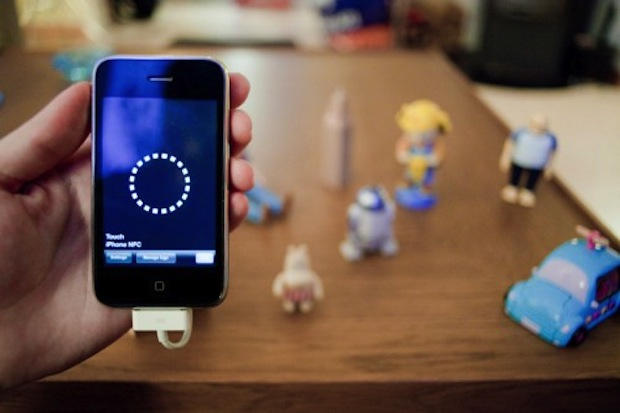If rumors that Apple is adding an RFID reader to the iPhone are true, it’s huge!
An RFID reader would turn the iPhone into an e-wallet — allowing you to pay for everything, from a cup of coffee to a subway ride. It could also turn the iPhone into an ID card, a security access system and an electronic ticketing device.
It’s could also function as an easy and secure online shopping system that doesn’t require you to enter your credit card number.
Your iPhone could unlock your car, pick up e-coupons at the local mall, and pay for all your supermarket groceries just by laying it on top of the checkout.
Imagine if such a system was enabled on your iPhone. It would supplant your wallet — if enough retailers adopted the system, of course.
In Japan, such electronic payment systems are growing in popularity; the vast majority of Japanese cell phones have e-wallet capabilities. Sony, one of the leading companies behind e-wallets, is building its FeliCa system into all sorts of products, from the latest LCD TVs, to Vaio computers and the PlayStation.
Called ‘Osaifu‘ (wallet), the system has myriad uses, from an electronic keycard to a ticketing for Japan Airlines. MacDonalds in Tokyo uses it as a payment and loyalty program.
“You launch the McDonalds app, search for a coupon and input your order, and place your phone on a device that will take order and then to another device to make the payment,” said Japanaese journalist Nobiyuki Hayashi, who uses the system regularly.
The McDonalds sytem is used by about half-a-million users, Hayashi says. Hayashi also uses his Osaifu mobile to pay for groceries at a store that has no cashiers whatsoever. After scanning his groceries, he places his phone on a special RFID reading pad, and his purchases are paid for.
Apple has filed several patents related to RFID, including using RFID to find and connect to WiFi networks, and a touchscreen RFID tag reader.
“Apple has built some prototypes of the next gen iPhone with an RFID reader built [in],” said the leader of the Near Field Communications Group on LinkedIn.
Apple, of course, would have to persuade a critcal mass of partners to support the system. At present, e-wallet systems have a chicken/egg problem, even though companies like Nokia have been pushing such systems for years.
Of course, Apple could use e-payments in its own stores, and probably wouldn’t have any trouble persuading companies like Disney and maybe Starbucks (which has partnered with Apple int he past) to join the program.
Apple could easily create a payment system linked to iTunes.
In Japan, the e-wallet has become indispensable.
“I use cash everyday,” says Hayashi, “but I can live without it in Tokyo.”

Leander Kahney is the editor and publisher of Cult of Mac.
Leander is a longtime technology reporter and the author of six acclaimed books about Apple, including two New York Times bestsellers: Jony Ive: The Genius Behind Apple’s Greatest Products and Inside Steve’s Brain, a biography of Steve Jobs.
He’s also written a top-selling biography of Apple CEO Tim Cook and authored Cult of Mac and Cult of iPod, which both won prestigious design awards. Most recently, he was co-author of Cult of Mac, 2nd Edition.
Leander has been reporting about Apple and technology for nearly 30 years.
Before founding Cult of Mac as an independent publication, Leander was news editor at Wired.com, where he was responsible for the day-to-day running of the Wired.com website. He headed up a team of six section editors, a dozen reporters and a large pool of freelancers. Together the team produced a daily digest of stories about the impact of science and technology, and won several awards, including several Webby Awards, 2X Knight-Batten Awards for Innovation in Journalism and the 2010 MIN (Magazine Industry Newsletter) award for best blog, among others.
Before being promoted to news editor, Leander was Wired.com’s senior reporter, primarily covering Apple. During that time, Leander published a ton of scoops, including the first in-depth report about the development of the iPod. Leander attended almost every keynote speech and special product launch presented by Steve Jobs, including the historic launches of the iPhone and iPad. He also reported from almost every Macworld Expo in the late ’90s and early ‘2000s, including, sadly, the last shows in Boston, San Francisco and Tokyo. His reporting for Wired.com formed the basis of the first Cult of Mac book, and subsequently this website.
Before joining Wired, Leander was a senior reporter at the legendary MacWeek, the storied and long-running weekly that documented Apple and its community in the 1980s and ’90s.
Leander has written for Wired magazine (including the Issue 16.04 cover story about Steve Jobs’ leadership at Apple, entitled Evil/Genius), Scientific American, The Guardian, The Observer, The San Francisco Chronicle and many other publications.
Leander has a postgrad diploma in artificial intelligence from the University of Aberdeen, and a BSc (Hons) in experimental psychology from the University of Sussex.
He has a diploma in journalism from the UK’s National Council for the Training of Journalists.
Leander lives in San Francisco, California, and is married with four children. He’s an avid biker and has ridden in many long-distance bike events, including California’s legendary Death Ride.
You can find out more about Leander on LinkedIn and Facebook. You can follow him on X at @lkahney or Instagram.


